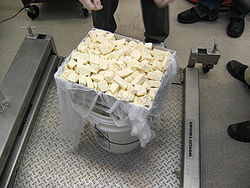
Manufacturing of Cheddar cheese
Encyclopedia
Milk
Generally, the milkMilk
Milk is a white liquid produced by the mammary glands of mammals. It is the primary source of nutrition for young mammals before they are able to digest other types of food. Early-lactation milk contains colostrum, which carries the mother's antibodies to the baby and can reduce the risk of many...
is raw milk
Raw milk
Raw milk is milk that has not been pasteurized or homogenized.-History:Humans consumed raw milk exclusively prior to the industrial revolution and the invention of the pasteurization process in 1864. During the industrial revolution large populations congregated into urban areas detached from the...
(whole or 3.3%). The milk must be "ripened" before adding in the rennet. The term ripening means allowing the Lactic acid bacteria
Lactobacillus
Lactobacillus is a genus of Gram-positive facultative anaerobic or microaerophilic rod-shaped bacteria. They are a major part of the lactic acid bacteria group, named as such because most of its members convert lactose and other sugars to lactic acid. They are common and usually benign...
(LAB) to turn lactose
Lactose
Lactose is a disaccharide sugar that is found most notably in milk and is formed from galactose and glucose. Lactose makes up around 2~8% of milk , although the amount varies among species and individuals. It is extracted from sweet or sour whey. The name comes from or , the Latin word for milk,...
into lactic acid
Lactic acid
Lactic acid, also known as milk acid, is a chemical compound that plays a role in various biochemical processes and was first isolated in 1780 by the Swedish chemist Carl Wilhelm Scheele. Lactic acid is a carboxylic acid with the chemical formula C3H6O3...
which lowers the pH
PH
In chemistry, pH is a measure of the acidity or basicity of an aqueous solution. Pure water is said to be neutral, with a pH close to 7.0 at . Solutions with a pH less than 7 are said to be acidic and solutions with a pH greater than 7 are basic or alkaline...
of the solution, greatly aiding in the coagulation
Coagulation
Coagulation is a complex process by which blood forms clots. It is an important part of hemostasis, the cessation of blood loss from a damaged vessel, wherein a damaged blood vessel wall is covered by a platelet and fibrin-containing clot to stop bleeding and begin repair of the damaged vessel...
of the milk. This is vital for the production of cheese curds that are later formed into Cheddar.
Rennet/chymosin/rennin
RennetRennet
Rennet is a complex of enzymes produced in any mammalian stomach to digest the mother's milk, and is often used in the production of cheese. Rennet contains many enzymes, including a proteolytic enzyme that coagulates the milk, causing it to separate into solids and liquid...
is an enzyme that was traditionally collected from the stomach of a milk-fed calf (natural rennet). This enzyme is responsible for the coagulation of the milk proteins to produce curds. Cheese produced this way is neither vegetarian nor Kosher. Coagulation can also be achieved using acids, but yields lower-quality Cheddar. The two key components of natural rennet are chymosin
Chymosin
Chymosin or rennin is an enzyme found in rennet. It is produced by cows in the lining of the abomasum...
and bovine pepsin. Extracts from plants such as nettles were found to produce similar effects, and have been used in some types of cheese-making (vegetable rennet).
When calf-rennet grew scarce in the 1960s, scientists developed a synthesized type of Chymosin by fermenting certain bacteria or fungi (microbial rennet), but this also wasn't useful for all types of cheese-making. A solution using recombinant-gene (GMO
GMO
A GMO is a genetically modified organism.GMO may also refer to:* Gell-Mann–Okubo mass formula in particle physics* General Medical Officer, a designation for United States Army soldiers* Generalised molecular orbital theory, in chemistry...
microbial rennet) technology was developed and approved by the U.S. Food and Drug Administration in 1990. This splices the calf-gene for producing chymosin into the genes of certain bacteria, yeasts or fungi, producing pure chymosin.
Equipment
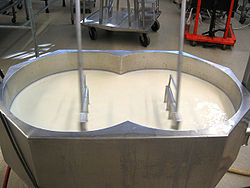
Vats will vary depending on a variety of factors. Generally oval or rectangle shaped with hollow walls that are used for holding warm water to keep the curds at desired temperatures. This part of the vat is referred to as the jacket.
A milling machine is used to cut the matted curds that are formed during the cheddaring process. This allows the curds to be easily salted.
Add rennet
Generally 3 to 4 oz (85 to 113.4 g) of rennet are added per 1000 lb (453.6 kg) of mix. The rennet will serve to coagulate the milk protein and form curds. The vat must be mixed thoroughly after the addition of the rennet to ensure equal mixing, and it also helps to dilute the rennet to make it easier to spread around.Pure water is used when diluting the rennet as any pH that is not near 7 will rapidly decrease the effectiveness of the rennet, as will chlorine. Thus, water with impurities will result in a vastly decreased yield of cheese.
Setting the curd
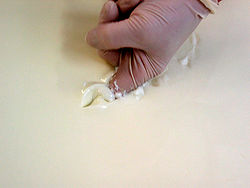
The most common way to determine when the curd is set is by inserting a flat blade at a 45 degree angle into the curd and raising it slowly. If the curd breaks cleanly leaving a glassy fracture, it is ready for cutting. In a large Cheddar manufacturing facility, this may also be tested using a viscometer
Viscometer
A viscometer is an instrument used to measure the viscosity of a fluid. For liquids with viscosities which vary with flow conditions, an instrument called a rheometer is used...
.
Cutting the curd
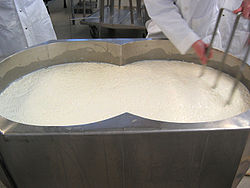
It is important that cutting time is minimized and that the cuts be clean. The best way to determine how efficient the cutting job was is to determine the fat content of the whey. The optimal level of fat content of whey is 0.3% fat or less.
The curds are handled gently after cutting to prevent fat and protein loss to the whey. The curd is prevented from sticking to the sides of the vat, but minimal agitation is desired. The curds are allowed to set again for 10 to 15 minutes. Fat and protein loss may affect the ability of the cheese to be considered Cheddar cheese, depending on the region where it is created (See Code of Federal Regulations
Code of Federal Regulations
The Code of Federal Regulations is the codification of the general and permanent rules and regulations published in the Federal Register by the executive departments and agencies of the Federal Government of the United States.The CFR is published by the Office of the Federal Register, an agency...
for US standards)
Cooking the curd
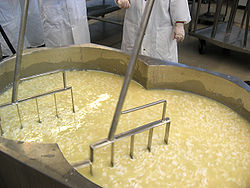
Draining the curds
Whey is removed from the curds by allowing it to drain out of the vat. A gate is generally present to prevent curds from escaping. When most of the whey is gone, the curds are raked to either side of the vat, allowing whey to drain down the middle of the two piles.Cutting loaves
"Loaves" of curds are cut about 15 centimetres (5.9 in) wide along each side of the vat. After ten minutes, the loaves are turned over and stacking begins.Stacking loaves
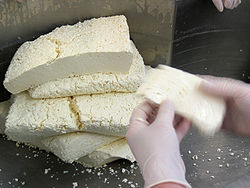
, so it is checked constantly.
Milling the curd

Salting
When all of the curd is milled, salt must be added. The amount of salt varies, but it will be between 1% and 3% by weight. The salt must be mixed thoroughly. Salt helps remove some of the whey from the cheese which lowers moisture content. Salt also adds to the flavour of the cheese. Salt will also stop the cheese from becoming too acidic, which imparts a bitter taste.Packaging and pressing
